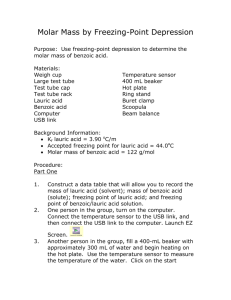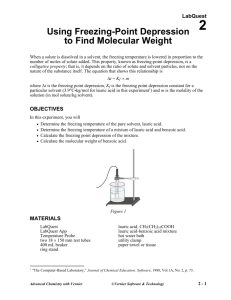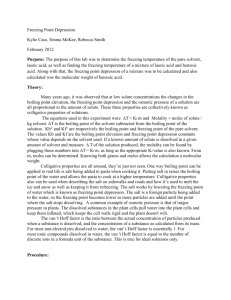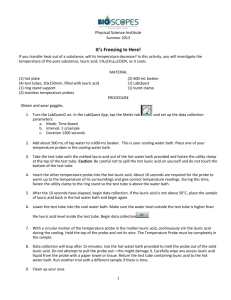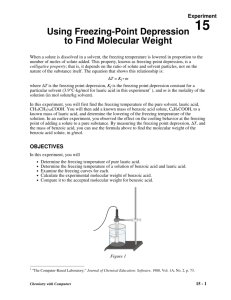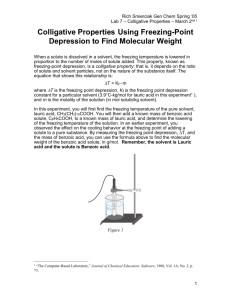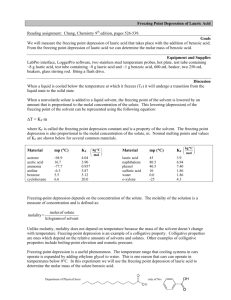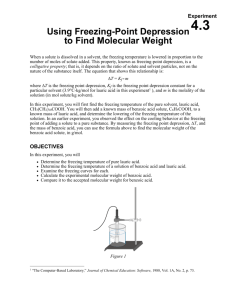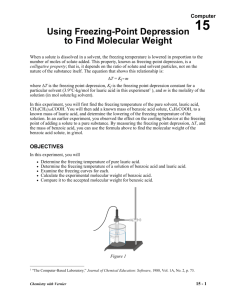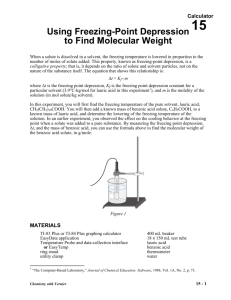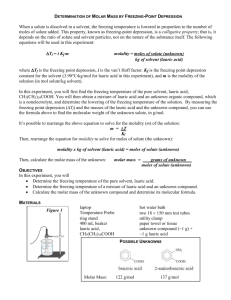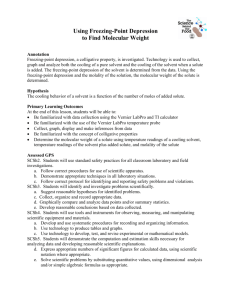When a solute is dissolved in a solvent, the freezing temperature is
advertisement
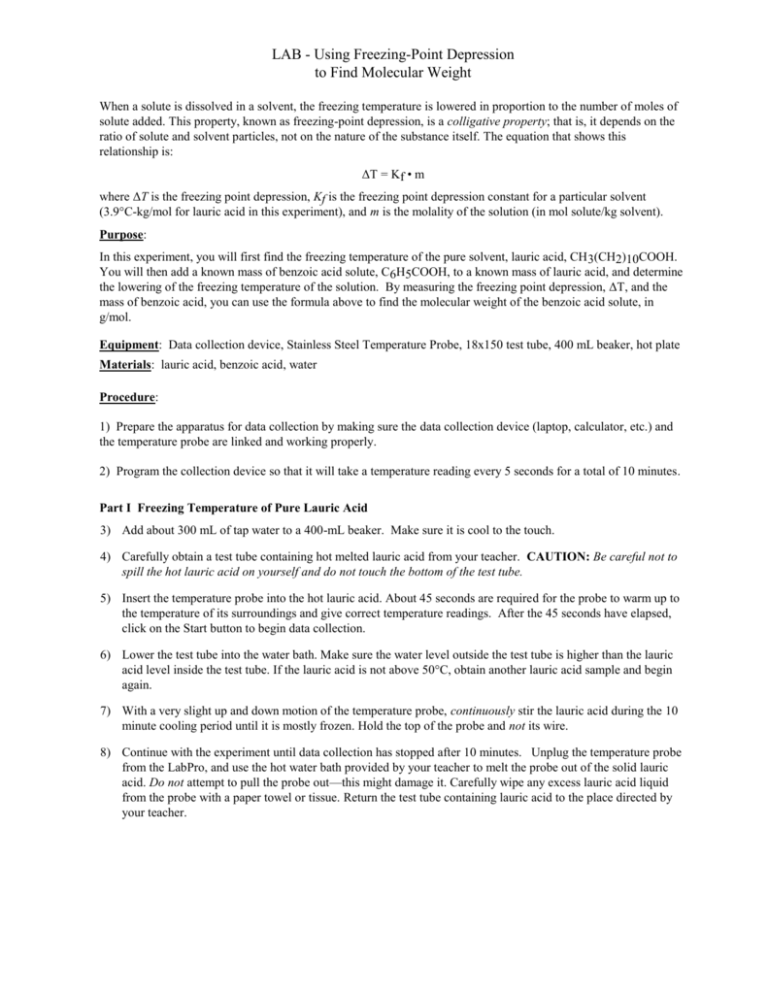
LAB - Using Freezing-Point Depression to Find Molecular Weight When a solute is dissolved in a solvent, the freezing temperature is lowered in proportion to the number of moles of solute added. This property, known as freezing-point depression, is a colligative property; that is, it depends on the ratio of solute and solvent particles, not on the nature of the substance itself. The equation that shows this relationship is: ΔT = Kf • m where ΔT is the freezing point depression, Kf is the freezing point depression constant for a particular solvent (3.9°C-kg/mol for lauric acid in this experiment), and m is the molality of the solution (in mol solute/kg solvent). Purpose: In this experiment, you will first find the freezing temperature of the pure solvent, lauric acid, CH 3(CH2)10COOH. You will then add a known mass of benzoic acid solute, C6H5COOH, to a known mass of lauric acid, and determine the lowering of the freezing temperature of the solution. By measuring the freezing point depression, ΔT, and the mass of benzoic acid, you can use the formula above to find the molecular weight of the benzoic acid solute, in g/mol. Equipment: Data collection device, Stainless Steel Temperature Probe, 18x150 test tube, 400 mL beaker, hot plate Materials: lauric acid, benzoic acid, water Procedure: 1) Prepare the apparatus for data collection by making sure the data collection device (laptop, calculator, etc.) and the temperature probe are linked and working properly. 2) Program the collection device so that it will take a temperature reading every 5 seconds for a total of 10 minutes. Part I Freezing Temperature of Pure Lauric Acid 3) Add about 300 mL of tap water to a 400-mL beaker. Make sure it is cool to the touch. 4) Carefully obtain a test tube containing hot melted lauric acid from your teacher. CAUTION: Be careful not to spill the hot lauric acid on yourself and do not touch the bottom of the test tube. 5) Insert the temperature probe into the hot lauric acid. About 45 seconds are required for the probe to warm up to the temperature of its surroundings and give correct temperature readings. After the 45 seconds have elapsed, click on the Start button to begin data collection. 6) Lower the test tube into the water bath. Make sure the water level outside the test tube is higher than the lauric acid level inside the test tube. If the lauric acid is not above 50°C, obtain another lauric acid sample and begin again. 7) With a very slight up and down motion of the temperature probe, continuously stir the lauric acid during the 10 minute cooling period until it is mostly frozen. Hold the top of the probe and not its wire. 8) Continue with the experiment until data collection has stopped after 10 minutes. Unplug the temperature probe from the LabPro, and use the hot water bath provided by your teacher to melt the probe out of the solid lauric acid. Do not attempt to pull the probe out—this might damage it. Carefully wipe any excess lauric acid liquid from the probe with a paper towel or tissue. Return the test tube containing lauric acid to the place directed by your teacher. 9. Make sure you see a graph of your data. Select the area on the graph (and the corresponding data) where the temperature remained constant (see Figure 1). Use the collection device to analyze this area and provide statistics (mean, max, min, etc.). Record the mean as your melting temperature for lauric acid. Save and print out a graph and data table. Figure 1 Part II Freezing Temperature of a Solution of Benzoic Acid and Lauric Acid 10. Measure ~0.6 g of benzoic acid and ~5 g of lauric acid into separate weigh boats. Record the precise masses of benzoic acid and lauric acid in your data table. Put both solids into your test tube, and place the test tube in a hot water bath to melt them into a solution. Repeat Steps 3-8 to determine the freezing point of this mixture. When you are finished, dispose of your test tube as directed by your instructor. 11. At the completion of the 10 minutes, make sure the graph is displayed. To determine the freezing point of the benzoic acid-lauric acid solution, you need to determine the temperature at which the mixture first started to freeze. Unlike pure lauric acid, cooling a mixture of benzoic acid and lauric acid results in a slow gradual drop in temperature during the time period when freezing takes place. Scroll through the data points to locate the freezing point of the solution, as shown in Figure 2. Record the freezing point (yvalue) in the Data and Calculations table. Figure 2 12. Save and print out a graph and data table. Calculations/Conclusions 1. Determine the difference in freezing temperatures, ΔT, between the pure lauric acid (t1) and the mixture of lauric acid and benzoic acid (t2). Use the formula, ΔT = T1 - T2. 2. Calculate molality (m), in mol/kg, using the formula, Δt = Kf • m (Kf = 3.9°C-kg/mol for lauric acid). 3. Calculate moles of benzoic acid solute, using the answer in Step 2 (in mol/kg) and the mass (in kg) of lauric acid solvent. 4. Calculate the observedl molecular weight of benzoic acid, in g/mol. Use the original mass of benzoic acid from the Data and Calculations table, and the moles of benzoic acid you found in the previous step. 5. Determine the expected molecular weight for benzoic acid from its formula, C6H5COOH. 6. Calculate the percent error. 7. Include a full error analysis in your lab report. DATA AND CALCULATIONS Mass of lauric acid Mass of benzoic acid Freezing point of pure lauric acid Freezing point of the benzoic acid- lauric acid mixture ________ g ________ g ________ °C ________ °C Freezing temperature depression, t ________ °C Molality, m ________ mol/kg Moles of benzoic acid ________ mol Molecular weight of benzoic acid (experimental) ________ g/mol Molecular weight of benzoic acid (accepted) ________ g/mol Percent error Observed - Expected x100% % Error = Expected ________ %
